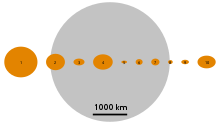5 Astraea
| Discovery | |
|---|---|
| Discovered by | Karl Ludwig Hencke |
| Discovery date | December 8, 1845 |
| Designations | |
| 1969 SE | |
| Main belt | |
| Orbital characteristics | |
| Epoch November 26, 2005 (JD 2453700.5) | |
| Aphelion | 459.202 Gm (3.070 AU) |
| Perihelion | 310.688 Gm (2.077 AU) |
| 384.945 Gm (2.573 AU) | |
| Eccentricity | 0.193 |
| 1507.676 d (4.13 a) | |
Average orbital speed | 18.39 km/s |
| 194.442° | |
| Inclination | 5.369° |
| 141.690° | |
| 357.530° | |
| Physical characteristics | |
| Dimensions | 167×123×82 km[1][2] |
| Mass | ~2.4×1018 kg |
Mean density | ~2.7 g/cm³[3] |
| ~0.023 m/s² | |
| ~0.062 km/s | |
| 0.700 03 d (16.801 h)[2] | |
| Albedo | 0.227 (geometric)[1] |
| Temperature | ~167 K max: 263 K (-10 °C) |
Spectral type | S-type asteroid |
| 8.7 to 12.92 | |
| 6.85 | |
| 0.15" to 0.041" | |
5 Astraea (written Astræa in the early literature) is a big main belt asteroid. Its surface is very reflective (bright) and what it's made of is probably a mixture of nickel-iron with magnesium- and iron-silicates. The adjectival form of the name, although unused, would be Astraean (which also designates a genus of star corals).

Astraea was the fifth asteroid found, on December 8, 1845 by K. L. Hencke. It was his first of two asteroid discoveries. The second was 6 Hebe. An amateur astronomer and post office employee, Hencke was looking for 4 Vesta when he stumbled on Astraea. The King of Prussia awarded him with an annual pension of 300 US$ (1968 dollars) for the discovery.[4]
Photometry indicates prograde rotation, that the north pole points in the direction of right ascension 9 h 52 min, declination 73° with a 5° uncertainty.[2] This gives an axial tilt of about 33°.
Astrea is physically unremarkable but notable mainly because for 38 years (after the discovery of Vesta in 1807) it had been thought that there were only four asteroids. In terms of maximum brightness, it is indeed only the seventeenth brightest main belt asteroid, being fainter than 192 Nausikaa and even, at rare near-perihelion oppositions, the highly eccentric carbonaceous 324 Bamberga.
After the discovery of Astraea, thousands of other asteroids would follow. Indeed, the discovery of Astrea proved to be the starting point for the eventual demotion of the four original asteroids (which were regarded as planets at the time) to their current status, as it became apparent that these four were only the biggest of a whole new type of celestial body.
There has been only one seen stellar occultation by Astraea (February 2, 1991).
References[change | change source]
- Yeomans, Donald K. "Horizons system". NASA JPL. Retrieved 2007-03-20. — Horizons can be used to obtain a current ephemeris
- ↑ 1.0 1.1 "Supplemental IRAS Minor Planet Survey". Archived from the original on 2006-06-23. Retrieved 2007-12-17.
- ↑ 2.0 2.1 2.2 M. J. López-Gonzáles & E. Rodríguez Lightcurves and poles of seven asteroids, Planetary and Space Science, Vol. 53, p. 1147 (2005).
- ↑ G. A. Krasinsky et al. Hidden Mass in the Asteroid Belt, Icarus, Vol. 158, p. 98 (2002).
- ↑ "DAWN: A Journey to the Beginning of the Solar System". NASA: Jet Propulsion Laboratory; California Institute of Technology. Retrieved 20 July 2013.
Other websites[change | change source]
- AN 23 (1846) 393 (in German)
- MNRAS 7 (1846) 27
